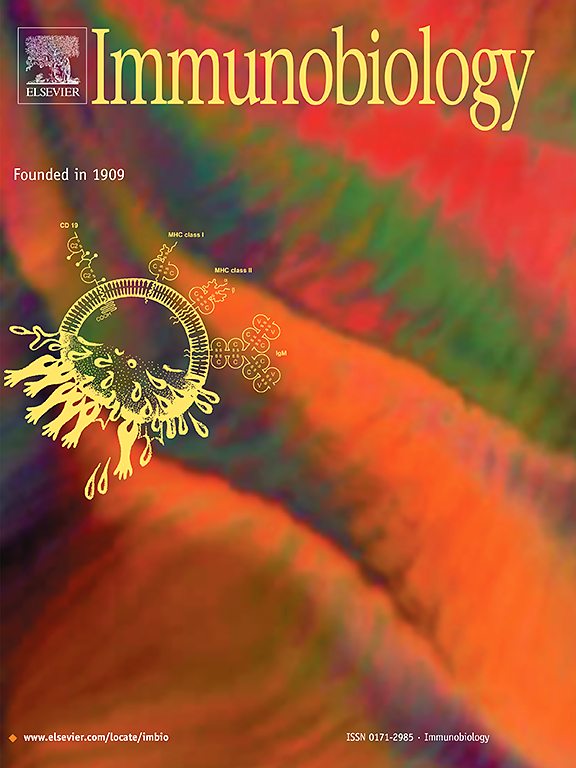Modulation of cytokine expression by E. coli Nissle 1917 and its OMV in intestinal epithelial cell line HT-29
IF 2.3
4区 医学
Q3 IMMUNOLOGY
引用次数: 0
Abstract
Inflammatory bowel disease (IBD) is a chronic disease recognized as an autoimmune disorder. The purpose of this is to determine the impact of the E. coli strain Nissle 1917 (EcN) and its outer membrane vesicles (OMVs) on cytokine gene expression in an IBD cell line model (HT29) in the hope that these effects will guide the development of interventional therapeutic strategies for IBD. First, the cell viability of HT-29 cells treated with EcN and OMVs was evaluated using the MTT assay. Then, inflamed HT29 cells were inoculated with EcN bacteria (multiplicity of infection (MOI) 10, 100), and extracted OMVs (10, 50 μg/ml). Subsequently, cells were harvested for RNA extraction; followed by expression analysis using real-time PCR and also the evaluation of cytokines by ELISA assay. TNF-α, IL-12, and IL-1β mRNA expression was decreased in EcN bacteria (MOI 10 and 100) and OMV 10 μg/ml group. IL-6 mRNA increased in the MOI 100 of ECN group but decreased in OMV μg/ml, despite elevated IL-6 protein levels in the OMV 50 μg/ml. Notably, no detectable secretion of IL-12, TNF-α, or IL-1β was observed in ELISA assays, suggesting post-transcriptional regulation or low sensitivity. The findings revealed that EcN (MOI 10 and 100) enhanced anti-inflammatory IL-10 production, whereas OMV 10 μg/ml showed superior suppression on mRNA level compared to OMV 50 μg/ml.

大肠杆菌Nissle 1917及其OMV对肠上皮细胞系HT-29细胞因子表达的调节
炎症性肠病(IBD)是一种被认为是自身免疫性疾病的慢性疾病。本研究旨在确定大肠杆菌Nissle 1917 (EcN)及其外膜囊泡(OMVs)对IBD细胞系模型(HT29)细胞因子基因表达的影响,以期为IBD介入治疗策略的制定提供指导。首先,使用MTT法评估EcN和omv处理HT-29细胞的细胞活力。然后用EcN菌(感染多重度(MOI) 10、100)接种HT29细胞,提取omv(10、50 μg/ml)。随后,收集细胞进行RNA提取;实时荧光定量PCR分析表达,ELISA法检测细胞因子。EcN菌(MOI 10和100)和OMV 10 μg/ml组TNF-α、IL-12和IL-1β mRNA表达降低。IL-6 mRNA在ECN组moi100中升高,在OMV μg/ml中降低,而在OMV 50 μg/ml中升高。值得注意的是,在ELISA检测中没有检测到IL-12、TNF-α或IL-1β的分泌,提示转录后调控或低敏感性。结果显示,EcN (MOI 10和100)可促进抗炎IL-10的产生,而OMV 10 μg/ml对mRNA水平的抑制作用优于OMV 50 μg/ml。
本文章由计算机程序翻译,如有差异,请以英文原文为准。
求助全文
约1分钟内获得全文
求助全文
来源期刊

Immunobiology
医学-免疫学
CiteScore
5.00
自引率
3.60%
发文量
108
审稿时长
55 days
期刊介绍:
Immunobiology is a peer-reviewed journal that publishes highly innovative research approaches for a wide range of immunological subjects, including
• Innate Immunity,
• Adaptive Immunity,
• Complement Biology,
• Macrophage and Dendritic Cell Biology,
• Parasite Immunology,
• Tumour Immunology,
• Clinical Immunology,
• Immunogenetics,
• Immunotherapy and
• Immunopathology of infectious, allergic and autoimmune disease.
 求助内容:
求助内容: 应助结果提醒方式:
应助结果提醒方式:


